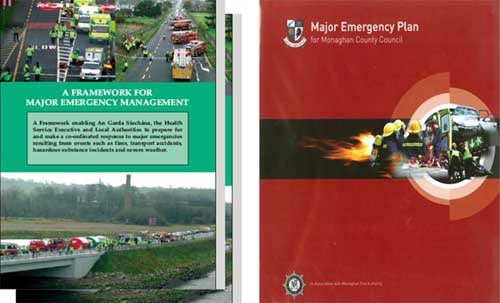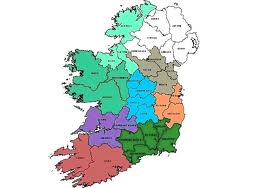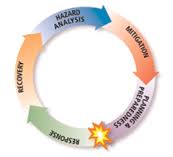 The framework for Major Emergency Management (2006) replaced the Framework for Co-ordinated Response to Major Emergency, which has underpinned major emergency preparedness and
The framework for Major Emergency Management (2006) replaced the Framework for Co-ordinated Response to Major Emergency, which has underpinned major emergency preparedness and
response capability since 1984. The 2006 Framework was prepared under the aegis of the Inter-Departmental Committee on Major Emergencies and was approved by Government decision. It enables the three principal emergency response agencies, An Garda Síochána, the Health Service Executive and Monaghan County Council to prepare and make a co-ordinated response to major emergencies resulting from fires, transport accidents, hazardous substances and severe weather.
It enables the three principal emergency response agencies, An Garda Síochána, the Health Service Executive and Monaghan County Council to prepare and make a co-ordinated response to major emergencies resulting from fires, transport accidents, hazardous substances and severe weather.
What is a Major Emergency?
“A Major Emergency is any event which, usually with little or no warning, causes or threatens death or injury, serious disruption of essential services or damage to property, the environment or infrastructure beyond the normal capabilities of the principal emergency services (An Garda Siochána, Health Service Executive and Monaghan County Council) and in the area in which the event occurs, and requires the activation of specific additional procedures and the mobilisation of additional resources to ensure an effective, co-ordinated response”.

Who are the Principal Response Agencies (PRA)?
The Principle Response Agencies responsible for Emergency Services in the North East region are:-
- Local Authorities i.e. Monaghan County Council, Cavan County Council, Meath County Council and Louth Local Authoities
- Health Service Executive: Dublin North East region comprising of counties Cavan, Louth, Meath, Monaghan and North Dublin.
- An Garda Síochána: Louth, Meath & Cavan / Monaghan Division.
Who are the Principal Emergency Services (PES)?
 The principal emergency services are the blue light services that respond to normal emergencies in Ireland, namely An Garda Síochána, the Ambulance Service and the Fire Service. A fourth principal emergency service, the Irish Coast Guard, is responsible for the initiation, control and co-ordination of maritime emergencies in the Irish territorial waters, harbours and coastline. The principal emergency services would be the first services to respond to most major emergencies.
The principal emergency services are the blue light services that respond to normal emergencies in Ireland, namely An Garda Síochána, the Ambulance Service and the Fire Service. A fourth principal emergency service, the Irish Coast Guard, is responsible for the initiation, control and co-ordination of maritime emergencies in the Irish territorial waters, harbours and coastline. The principal emergency services would be the first services to respond to most major emergencies.
What is the organisational structure within Ireland?
The organisation structure for emergency planning in Ireland is broken down into three levels;
- National Level: The Government has formed a National Steering Group (NSG) to oversee the development and implementation of the Major Emergency Development Programme. The NSG established a National Working Group (NWG) to progress the programme.
- Regional Level: There are eight regions for Major Emergency planning within the Irish Republic. Monaghan County Council belongs to the North East region. This region incorporates the following counties;
- Cavan
- Louth
- Monaghan
- Meath
 An inter-agency Regional Steering Group has been formed for the Major Emergency Region of the North East. This group is representative of senior management from each of the principle response agencies (PRAs). In addition an inter-agency Regional Working Group has been formed. This group is representative of senior operational managers from each of the principle response agencies (PRAs). The RWG meet on a regular basis.
An inter-agency Regional Steering Group has been formed for the Major Emergency Region of the North East. This group is representative of senior management from each of the principle response agencies (PRAs). In addition an inter-agency Regional Working Group has been formed. This group is representative of senior operational managers from each of the principle response agencies (PRAs). The RWG meet on a regular basis.
Local Authority Level: Responsibility for overseeing the implementation of emergency planning within Monaghan County Council has been assigned to Director of Services for Emergency Services. He will be supported by the Senior Fire Officers from Monaghan Fire Authority. There are appropriate inputs from the other sections of the local authority.
Who may declare a major emergency?
Any one of the principal response agencies may declare a major emergency. The highest-ranking member of each of the first emergency teams to arrive on site carries out a situation appraisal. It is the task of these individuals to survey the site and accumulate all available information that may be used to arrive at a decision. Each principal response agency has personnel authorised and trained in the procedures for declaring a major emergency.
Are there risks within Co. Monaghan?
Yes, there are generic threats that exist in all communities in Ireland and these are sometimes taken for granted (e.g. fires, road traffic accidents, accidents involving transport of people, hazardous materials, building collapse). The generic threats that exist locally and regionally generally fall into four commonly used categories:
- Natural: Incidents involving severe weather, geological issues such as earthquakes, landslides etc.
- Transportation: Incidents involving aircraft, road and rail.
- Technological: Incidents at industrial premises and installations containing hazardous material, large building fires, building collapses etc.
- Civil: Terrorism, civil disorder, CCBRN, Diseases etc

There are a number of specific risks which were identified from the risk assessment process that was carried out by Monaghan County Council. These include the following;
- Severe weather incidents
- Aircraft collisions / loss
- Hazardous materials incidents
- Major R.T.A.
- Natural Gas explosions
- Industrial fires
Can an emergency become a regional emergency?
Yes. Under certain specific circumstances regional level major emergencies may be declared, with a Plan for Regional Level Co-ordination activated. This will provide for mutual aid, support and co-ordination facilities to be activated in the region, the boundaries of which are determined to suit the exigencies of the particular emergency.
Are there National Emergency Plans in place?
Yes. National plans have been created for specific emergencies. These plans will require the assistance of the principal response agencies. The roles and functions of the P.R.A. are contained in these plans. Arrangements involving the principal response agencies in National Emergency Plans will be agreed in the first instance on their behalf through the National Steering Group. The Major Emergency Plan for Monaghan County Council may be activated by one of those agencies on request from a body acting under the provisions of one of the following National Emergency Plans:
- Nuclear Emergency
- Public Health Infectious Diseases Emergency Plan
- Animal Diseases Plan
- Marine Emergency Plan
Is the new emergency plan in place?

Yes, the old 1984 emergency plan was replaced by the newer version on the 30th September 2008
History of Emergency events in Co. Monaghan
Major emergencies in their very nature do not occur frequently. A major emergency has never been declared in Co. Monaghan under the 1984 framework; however, Co Monaghan has experienced its share of emergency events over the last 30 years. Below is a list of events that has occurred;
- Monaghan bombing: 17th May 1974. 7 people killed.
- Castleblaney bombing: 7th March 1976. 1 person killed, 17 injured
- Nationwide snow Blizzards 1982.
- Foot & Mouth Spring 2001.